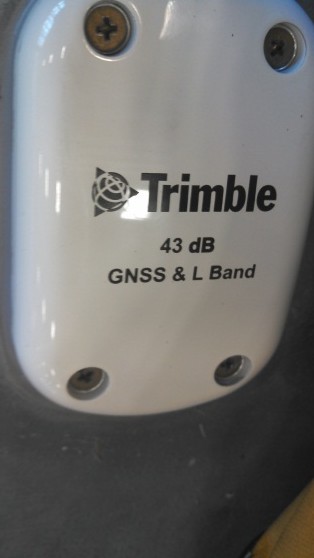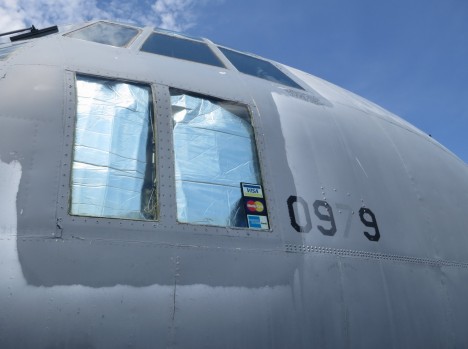

In early September, I drove down to Wallops Flight Facility to set up our GPS base station in preparation for the test flight. The test flight is to verify that everything is working as expected, and to do some calibration, since the C-130 is a new platform for the Land, Vegetation, and Ice Sensor (LVIS). LVIS gathers data by sending out short laser beam pulses that bounce off the ground and give us the elevation of the terrain. Calibration ensures that we can pinpoint to within an inch where the laser hits the ground. We need to know exactly where the instrument is, and what it is seeing on the ground.
We use GPS receivers both on the ground and in the plane to track the position of the instrument. That’s where I come in. I set up the GPS ground station, which consists of GPS receivers and an antenna. In the field we usually get a rundown shack and we have to set up our own antenna. The Wallops GPS building was luxurious in comparison. It was spacious, air-conditioned, and had a permanent antenna built in, which meant I didn’t have to set up a tripod. I hooked up three ground receivers to the antenna, verified that they were working and started recording data. We do this for up to five days, in order to calculate precisely the location of the ground antenna.
I also tested the GPS antenna on the plane. It’s a different model from the ground antenna and is bolted to the top of the plane. A cable runs down from it so we can hook up the receivers. Just like for the ground receivers, I verify that they are working and recording data correctly.

GPS antenna aboard the C-130
The C-130 is a rugged cargo plane. One of our instrument racks, filled with equipment necessary to operate LVIS, was sitting on the hangar floor outside the plane, waiting to be moved into place and bolted down. I got a look at the current state of the in-flight facilities and took pictures for the team back home. There had been much discussion on the subject since some of our flights may last up to 10 hours. We never imagined we’d be discussing these issues when we were in school! It’s all part of the field work experience.
At the end of the day, I collected and verified the GPS data available and left the ground receivers running. Everything was working as expected, so it was time for me to make the three hour trek back home. No traffic and beautiful scenery made for a pleasant drive.
Editor’s note: In fall 2013, researchers aboard a NASA C-130 traveled to Greenland to study changes in the ice sheet and sea ice following the summer melt season. Other airborne campaigns, like NASA’s Operation IceBridge, study changes on an annual basis and this is the first large-scale airborne survey of seasonal change. The C-130, equipped with a pair of Land, Vegetation and Ice Sensor (LVIS) laser altimeters, will carry out surveys of land and sea ice from Oct. 31 to mid-November and will resurvey many of the same areas flown by IceBridge during its 2013 Arctic campaign.
In late August, David Rabine and I headed down to Wallops Flight Facility in Virginia to start LVIS instrument installation for NASA’s Greenland airborne campaign.
It was my first time at Wallops and I was thoroughly impressed with the amount of airborne activity that takes place there. It seems like every 15 minutes there is a plane taking off or landing! Once there we saw the C-130 that will carry our two LVIS instruments. It looks like a great platform for scientific measurement. It has a huge cargo door in the back that allowed us to literally roll the pallet with all the equipment and the two instruments on board.

NASA’s C-130 aircraft on the tarmac at Wallops Flight Facility in Virginia. Members of the LVIS instrument team are installing equipment in preparation for the upcoming IceBridge Greenland campaign.

: The C-130 also had a sticker with major credit card logos on one of its windows. Perhaps this means they accept them for the in-flight entertainment.
Another benefit of the C-130 is the space available inside, which allows us to use four equipment racks without having to worry about space, and put the two LVIS instruments side-by-side. This will let us build a great data product. We spent a week populating our equipment racks, and by the end of it we had most of the equipment for the regular LVIS instrument mounted into its appropriate rack. Next came the equipment for the Global Hawk version and after finishing the equipment racks, we installed the two LVIS instruments onto a custom built platform that holds them in place.
We were very fortunate that our trip to Wallops lined up with a test flight of one of NASA’s Global Hawks, an uninhabited aerial vehicle that’s taking part in another NASA mission, the Hurricanes and Severe Storms Sentinel, or HS3, mission, and which the smaller version of LVIS has flown on before. As luck would have it, on the morning of Aug. 20 the Global Hawk took off on the runway that was closest to our airplane hangar. We were able to get a front seat view of the takeoff.